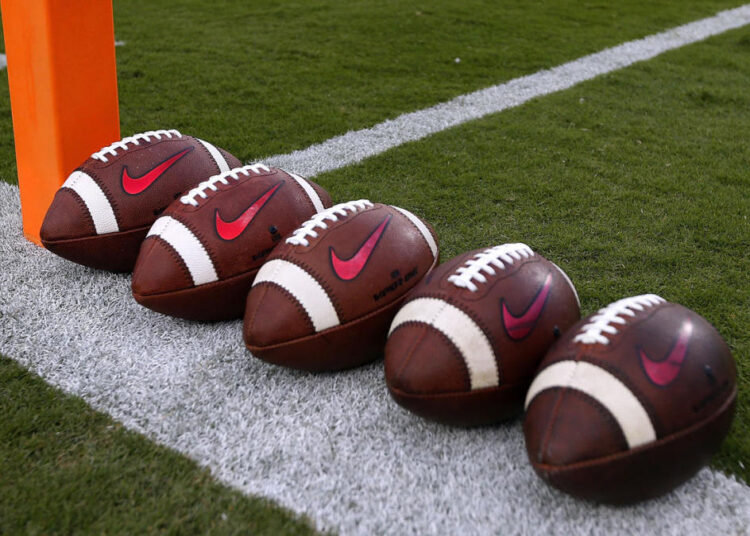A college football official volunteering his time slipped into press boxes around the country last season. Unannounced and anonymous, his duties: dig into how many plays could be saved if one of the hallmark rules of the sport were altered.
The official was tasked with determining how much time could be saved by simply letting the clock run after first downs except during the last 2 minutes of each half. Clock stoppages on first down have separated college football from the NFL since 1968. It is about to become a line in the sand as the NCAA Football Rules Committee convenes its annual meeting beginning next week in Indianapolis.
A convergence of issues has compelled the game’s stakeholders to consider more seriously limiting “exposures,” the number of plays per game that athletes are on the field. The intent is not necessarily to shorten game lengths but rather protect players’ health.
A similar initiative failed last year, but as time has passed, the urgency has increased.
Forget about the structure of the game for a moment. What comes out of that meeting will determine how all of college football approaches the future from a medical liability standpoint.
“Whether it’s sickle cell or anything else, we don’t get the NCAA to do anything until they get sued, or frankly, [the media] rips them to shreds for not doing anything on it,” said Eugene Egdorf, a veteran Houston attorney who has battled the NCAA on numerous occasions.
The committee is also expected to consider allowing the clock run after incomplete passes. In either case, if the committee acts, exposures would be reduced. But at what cost?
College executives have been told the average offense would lose about seven plays per game if the clock was allowed to run after first downs. That’s less impactful than letting the clock run after incomplete passes, which projects to remove 18-20 plays from each contest, fundamentally changing the game’s structure. Especially in a sport where a record 46% of snaps were passing plays in 2022.
(Also being considered: no longer allowing consecutive timeouts to “ice” a kicker nor extending a period for untimed downs due to a defensive penalty. Both of those considerations are believed to be non-controversial.)
More than one source called the difference in exposures between NFL and college being a possible inflection point. NFL games average 155 plays per game (including extra points, kickoffs, two-point plays). In the FBS, the average is around 180.
Some question whether that delta should exist with young adults, non-professionals (many of whom are teenagers) facing 16% more plays than paid professionals. Add to that the expanded College Football Playoff creating the possibility of a 17-game season and some college football players could be on the field for the equivalent of an NFL regular season.
That’s one reason ACC commissioner Jim Phillips initially stood against playoff expansion. Phillips was chair of the College Football Officials (CFO) board of managers that put forth the initial proposals. The board consists of all 10 FBS commissioners with FCS representatives.
The FBS commissioners met last December in Las Vegas to discuss the changes. At least three contacted by CBS Sports are in favor of some change because it will theoretically improve health and safety without incurring any extra costs. No matter what, the changes being discussed are considered highly contentious.
One official told CBS Sports to expect a “rip-roaring discussion” when the committee meets beginning Feb. 27 in Indianapolis. An NCAA announcement on any changes is expected by the end of the week on March 3.
Plays per FBS game have already decreased across three straight seasons. In fact, the overwhelming majority of catastrophic injuries come during the offseason when players aren’t even playing the game. However, there is concern that tempo offenses will simply move faster to get their plays in while the clock continues to run.
Then there are the purists who don’t want the college game to become more like the compartmentalized NFL. While the average time of game was up slightly in 2022 (3 hours, 21 minutes), it was stressed these changes would be more about player safety than shortening the game.
Georgia coach Kirby Smart is the only Power Five coach currently on the 11-person rules committee. He was part of the group that rejected similar changes last year.
Steve Shaw, NCAA secretary editor of the committee, oversaw a study that chronicled exposures across every FBS game from 2007-21.
“Our big brother in this world of football is the NFL,” Smart said last month at the CFP National Championship. “So much of what we do is modeled off what they do. They spend a lot, a lot, a lot of money to get it right. They’ve shrunk their game into a time frame that is probably a little bit tighter window than ours.
“They’re also trying to limit exposures as well, although they have a longer season, and they have added games to that season. It’s a big decision. We are dealing with student-athletes. I think it starts with that. I wouldn’t sit up here and say I’m favor of shrinking the game. I do think our game has gotten long and there are a lot of plays.”
The cost of not doing anything this time around could impact the NCAA in court. As CBS Sports pointed out in late 2021, any retreat on the targeting rule would be red meat for attorneys eager to allege the NCAA was backing off on player safety.
There must be concern from that standpoint if the committee doesn’t act two consecutive years on similar player-safety rules changes. While course-of-game rules changes are allowed only every other year, those that pertain to player safety can be added or amended at any time.
The number of FBS games has grown incrementally. In 1992, the SEC added a championship game — at the time, a 12th game for its two division winners. Every FBS conference eventually followed. A 12th regular-season game was added in 2006 as athletic directors sought additional revenue.
The four-team playoff was added in 2014 making it possible for two teams to play 15 games through the postseason. With the expanded playoff arriving in 2024, it will be possible for one or both championship participants to play 17 games.
Eliminating the 2020 COVID-19 season, Georgia has played the equivalent of more than a full extra regular-season (13 additional games) since 2017. With the playoff expanding from four to 12 teams (and from three to 11 games), those extra contests will increase for more playoff teams.
The SEC commissioned a study in 2021 that estimated how many plays would be saved by allowing the clock to run after incomplete passes. The equivalent of 1.65 regular-season games would have been saved. In a 16-game schedule (including the playoff), that number would be the equivalent of 2.2 fewer games.
When a working group presented the 12-team playoff model in 2021, the average increase in games was though to be minimal. For example, it’s possible that at least four teams would play only 13 games if they lost a first-round matchup, equivalent to the number of games most bowl-eligible teams play.
At stake this time, in some respect, is who carries that medical liability for athletes in the sport’s bold new future. In September, the NCAA’s former CFO described in detail to a group of FBS ADs how much it cost to run major-college football, a sport in which the association does not sponsor a championship. As part of that expense, the CFO said it costs the NCAA approximately $10 million annually in legal liability. Part of that obviously involves athlete health and welfare in court cases.
The NCAA continues to assert it is not legally responsible for the health and safety of players. It also continues to fight dozens of lawsuits involving medical issues that contend otherwise. (The NCAA was found not to be liable in two recent cases.)
“I believe strongly in a balance between health and not completely bastardizing the game,” Egdorf said. “Changing the first-down rule makes sense. Trying to figure out what you can do with the hurry up [offense] makes sense. Changing incomplete [passes to a running clock] does not make sense to me.
“I really want more discussion about a lot less practice than there is now. Studies show guys just get more hits in practice. That’s just how it is.”
While the 10 FBS commissioners will be influential, changes come down to the 11 persons on that rules committee. They range from a Division III offensive coordinator to a senior associate FCS Patriot League commissioner to a national championship coach at the highest level (Smart).
That variance may be enough to keep the changes from passing. With fewer plays, Division II and Division III games could be reduced to less than 2 hours and 20 minutes, according Todd Berry, executive director of the American Football Coaches Association and ex-member of the committee.
“Division II and Division II will probably revolt,” Berry told CBS Sports. “Their game times are still underneath 3 hours. They’re running the exact same offenses. … I think one of the beauties of the college game is that our rules are the same across the board.”
That might eventually lead to a future FBS rules committee instead of one that oversees 538 schools across three divisions. But that’s hardly the issue at the moment.
Part of the charm of college football is its proliferation of plays and higher-scoring games. More football is never a bad thing, right?
The Buccaneers led the NFL with 68.8 plays per game last season, a total that would have tied for 85th in the FBS. Texas Tech led FBS last season averaging 89.2 plays; in three games, it ran at least 103 plays.
There are pressures in the college game that are accounted for the pros. The NFL has a players’ union, collective bargaining, medical care. NCAA athletes obviously do not.
“Our football leadership group [reacted] in June 2021,” said SEC commissioner Greg Sankey. “The first thing was, ‘It’s not the number of games. It’s exposures over the year.’ It came from the young people involved in our programs, and I’ve not forgotten that message.”
In 2006, similar timing changes were disastrous. That year, the clock started when toe met ball on kickoffs. Also, the clock started on the “ready for play” signal from the referee, not when the ball is snapped after a change of possession.
The drop in the number of plays per game was so profound that the changes lasted only one season. Total plays declined by more than 13 per game on average. The drop in average yards per team (33) was the most since 1954. The scoring average per team (24.1 points) remains the lowest in the last 32 years.
Two years later, two significant changes were implemented seamlessly. On running plays out of bounds, the clock was started when the ball was deemed ready for play by the referee, not at the snap. Additionally, a 40-second play clock started after each dead ball.
Those have been the most notable changes to this point; whether more will come in early March remains to be seen.
Read the full article here

























